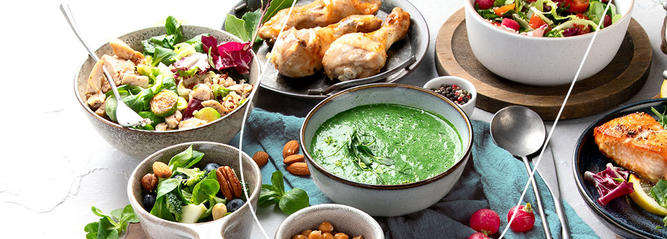1. Diabetes diet: a healthy, balanced diet for diabetes | Diabetes UK. Accessed 16 September, 2025. https://www.diabetes.org.uk/living-with-diabetes/eating/what-is-a-healthy-balanced-diet
2. Fats and diabetes | Diabetes UK. Accessed 16 September, 2025. https://www.diabetes.org.uk/living-with-diabetes/eating/fats-and-diabetes
3. Diabetes - causes, symptoms & treatments | British Heart Foundation. Accessed 16 September, 2025. https://www.bhf.org.uk/informationsupport/risk-factors/diabetes
4. Fats explained | British Heart Foundation. Accessed 16 September, 2025. https://www.bhf.org.uk/informationsupport/support/healthy-living/healthy-eating/fats-explained
5. How can I make salads healthier? | British Heart Foundation. Accessed 16 September, 2025. https://www.bhf.org.uk/informationsupport/heart-matters-magazine/nutrition/ask-the-expert/healthy-salads-and-dressings
6. European Commission. Trans fat in food - European Commission. Accessed February 13, 2025. https://food.ec.europa.eu/safety/labelling-and-nutrition/trans-fat-food_en
7. Fibre and diabetes | Diabetes UK. Accessed 16 September, 2025. https://www.diabetes.org.uk/living-with-diabetes/eating/carbohydrates-and-diabetes/fibre-and-diabetes
8. Van Ittersum K, Wansink B. Plate Size and Color Suggestibility: The Delboeuf Illusion’s Bias on Serving and Eating Behavior. J Consum Res. 2012;39(2):215-228. doi:10.1086/662615
9. Diabetes Meal Plan for Beginners. EatingWell. Accessed Februrary 13, 2025. https://www.eatingwell.com/article/7886108/diabetes-meal-plan-for-beginners/
10. Alkhulaifi F, Darkoh C. Meal Timing, Meal Frequency and Metabolic Syndrome. Nutrients. 2022;14(9):1719. doi:10.3390/nu14091719
11. Ahola AJ, Mutter S, Forsblom C, Harjutsalo V, Groop PH. Meal timing, meal frequency, and breakfast skipping in adult individuals with type 1 diabetes – associations with glycaemic control. Sci Rep. 2019;9(1):20063. doi:10.1038/s41598-019-56541-5
12. Carbohydrates and diabetes: What you need to know | Diabetes UK. Accessed 16 September, 2025. https://www.diabetes.org.uk/living-with-diabetes/eating/carbohydrates-and-diabetes
13. Brazeau AS, Mircescu H, Desjardins K, et al. Carbohydrate counting accuracy and blood glucose variability in adults with type 1 diabetes. Diabetes Res Clin Pract. 2013;99(1):19-23. doi:10.1016/j.diabres.2012.10.024
14. Portion sizes and diabetes | Diabetes UK. Accessed 16 September, 2025. https://www.diabetes.org.uk/living-with-diabetes/eating/portion-sizes
15. The Eatwell Guide | NHS. Accessed 16 September, 2025. https://www.nhs.uk/live-well/eat-well/food-guidelines-and-food-labels/the-eatwell-guide/
